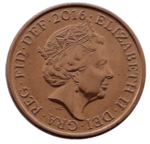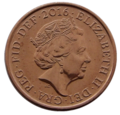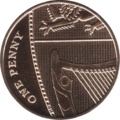Penny (British decimal coin) facts for kids
| United Kingdom | |
| Value | £0.01 |
|---|---|
| Mass | 3.56 g |
| Diameter | 20.3 mm |
| Thickness | (Bronze) 1.52 mm (Steel) 1.65 mm |
| Edge | Plain |
| Composition | Bronze (1971–1991) Copper-plated steel (1992–) |
| Years of minting | 1971–present |
| Obverse | |
 |
|
| Design | Queen Elizabeth II |
| Designer | Jody Clark |
| Design date | 2015 |
| Reverse | |
 |
|
| Design | Segment of the Royal Shield |
| Designer | Matthew Dent |
| Design date | 2008 |
The British one penny (1p) coin is a small piece of money used in the United Kingdom. It is worth one hundredth (1/100) of a pound.
Since it was first made on 15 February 1971, the coin has shown the face of the reigning monarch. When the coin was introduced, it featured Queen Elizabeth II. After her death in 2022, a new picture of King Charles III was added.
The back of the coin, called the reverse, shows a part of the Royal Shield. This design was created by Matthew Dent in 2008. The penny is the lowest value coin ever used in the United Kingdom.
The penny coin was first made from bronze. But since 1992, it has been made from copper-plated steel. This change happened because copper became more expensive.
There are about 10.5 billion 1p coins in use. This means there's a lot of pennies out there!
Contents
What Does 'Penny' Mean?
The word penny comes from an old English word, penig. When you talk about more than one penny coin, you say pennies (like "I have fifty pennies"). But when you talk about an amount of money, you say pence (like "This costs twenty pence").
How the Penny Coin Changed
Before 1971, the United Kingdom used a different money system. It was called pounds, shillings, and pence. In 1966, the government decided to switch to a simpler system. One pound would now be worth 100 pence, instead of 240 pence. This big change was called decimalisation.
New coins were needed for this new system. The first 1p coins were made in December 1968. They were produced at the new Royal Mint factory in Llantrisant, South Wales. On 15 February 1971, the new decimal coins, including the 1p, officially started being used.
What the Penny is Made Of
From 1971 to 1992, the 1p coin was made of bronze. This metal is mostly copper, with a little zinc and tin.
But the price of copper around the world started to go up. Because of this, the Royal Mint changed what the coin was made of. Since 1992, 1p coins are made from steel with a thin layer of copper on top. This makes them magnetic! If you have an old 1p coin from before 1992, it might be worth more than 1p just for the metal inside it. However, melting down coins in the UK is against the law.
The Queen's Portraits on the Coin
Over the years, four different pictures of Queen Elizabeth II have been used on the front (obverse) of the 1p coin. Each picture was designed by a different artist.
- The first portrait was by Arnold Machin. It showed the Queen wearing a special crown called the 'Girls of Great Britain and Ireland' Tiara. This design was used from 1971 until 1984.
- From 1985 to 1997, a portrait by Raphael Maklouf was used. This picture showed the Queen wearing a different crown, the George IV State Diadem, along with earrings and a necklace.
- In 1997, Ian Rank-Broadley designed a new portrait. His design showed the Queen looking more realistic. This portrait was used from 1998 to 2015.
- The last portrait of Queen Elizabeth II was designed by Jody Clark in 2015. It also showed the Queen wearing the George IV State Diadem.
Designs on the Back of the Coin
The back (reverse) of the 1p coin has also changed over time.
The first design, used from 1971 to 2008, showed a crowned portcullis with chains. A portcullis is a strong gate often found at the entrance to a castle. This design was inspired by a symbol of King Henry VII. Below the portcullis was the number "1". Above it, it said either "NEW PENNY" (until 1981) or "ONE PENNY" (from 1982).
In 2005, the Royal Mint held a competition to create new designs for many British coins. Matthew Dent won this competition. His new designs were introduced in 2008.
Matthew Dent's design for the 1p coin shows a small part of the Royal Shield. If you put all the new coin designs (1p, 2p, 5p, 10p, 20p, 50p) together, they form the complete Royal Shield! The 1p coin shows the left side of the shield, which represents England and Northern Ireland.
What is the Penny's Status?
Legal Tender
A 1p coin is considered legal tender for amounts up to 20 pence. This means that if you owe someone money, they must accept 1p coins for debts up to 20p. However, for everyday shopping, shops don't have to accept any specific type of payment. They can choose what they accept.
Talking About Stopping the Penny
Sometimes, people talk about whether the 1p coin should still be used. In 2015, the government thought about getting rid of the 1p coin. But this idea was stopped because many people didn't like it.
In 2018, the government looked into the future of money in the UK. This led to more talk about possibly stopping the 1p and 2p coins. However, experts from the Bank of England said that stopping these coins would not cause big problems. They noted that people don't use copper coins as much anymore.
It's thought that about 60% of copper coins are only used once before they are put away or thrown away. Around 8% of 1p coins are even thrown away completely! This means the Royal Mint has to make many new 1p and 2p coins each year to replace the ones that disappear.
Some charities and businesses were worried about stopping the 1p coin. Charities feared they would get fewer donations in collection pots. Some businesses, like traditional seaside arcades, thought it would hurt their business.
However, in May 2019, the government announced that there were no plans to stop using copper coins. They wanted people to have a choice in how they spend their money. Interestingly, no 1p coins were made in 2018 because there were already enough in circulation.
Images for kids
See also
 In Spanish: Un penique para niños
In Spanish: Un penique para niños




